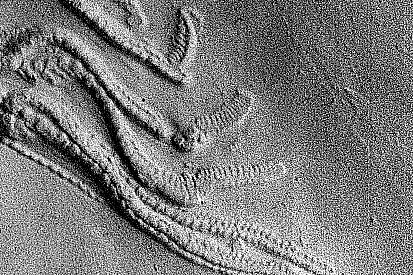
Details of the paper
| Title | Neue Beobachtungen an Codiacrinus |
| Year: | 1997 |
| Language: | German |
| Source: | Fossilien, 14, S. 235-239 |
| Keywords: | Hunsrückschiefer, observations, Codiacrinus, crinoid, systematic re-description, Natural History Museum, Leiden (NL) |
| Summary: | The inadunate Codiacrinus has been known for 130 years and is one of the commoner crinoids of the Hunsrück Slate. In the paper new observations on two excellent preserved specimens are described. They show details of the arm structure including tube feet, adambulacrals and ambulacrals. Photo: Naturalis |
| Reaction 1: | GLASS & BLAKE (2004) summarize in their article "Preservation of tube feet in an ophiuroid (Echinodermata) from the Lower Devonian Hunsrück Slate of Germany and a redescription of Bundenbachia beneckei and Palaeophiomyxa grandis" (Paläontologische Zeitschrift, 78(1), p. 76) the reports of soft-tissue preservation in Hunsrück Slate echinoderms. The observed preservation of tube feet along the arms and structures that SÜDKAMP interpreted as muscles between the brachials of the crinoid Codiacrinus schultzei, requires further detailed documentation. The muscle tissue can be mineralization between ossicles as observed in stelleroids by the authors. |
| Reaction 2: | Ausich et al. (2013), in their paper "Tube foot preservation in the Devonian crinoid Codiacrinus from the Lower Devonian Hunsrück Slate, Germany" (Lethaia, Vol. 46: 416-420), describe the first definitive proof of tube feet for any fossil crinoid. They refer to the tube feet and interplate muscles identified on C. schultzei by Südkamp (1997) and interpret the latter as ligamentary tissue. Cover plates were also identified on the German Mining Museum specimen in question. |

[Home] [Book - Life in Devonian] [Contact]
| Homepage last update: 25.04.2024 © ´2024 Südkamp - Exkursionen | wouter(x)suedkamp-exkursionen.de Impressum Datenschutz |
Webmaster: peter.holze(x)hunsnet.de |